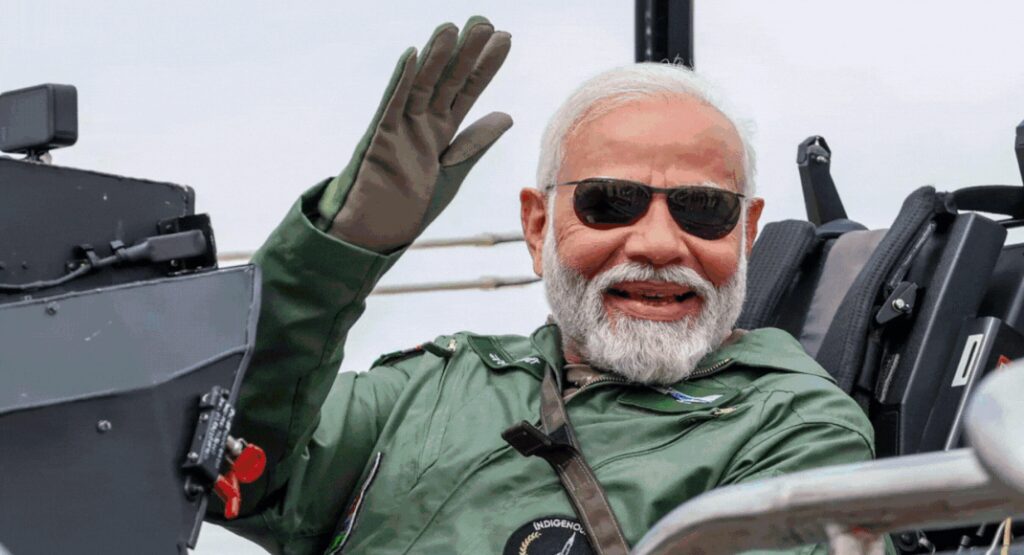[ad_1]
“The experience was incredibly enriching, significantly bolstering my confidence in our country’s indigenous capabilities, and leaving me with a renewed sense of pride and optimism about our national potential.A flight to remember! Tejas is India’s pride, a manifestation of the strength and skills of 140 crore Indians,” said Modi, after becoming the first PM to fly in a fighter jet.
‘Enriching experience, sense of pride’: PM Narendra Modi after flying Tejas Fighter Jet
The Tejas trainer in which he flew was piloted by Group Captain Debanjan Mandal, with IAF chief Air Chief Marshal VR Chaudhari present at the HAL airport in Bengaluru.
The capabilities of the light-weight, multi-role 4.5-generation Tejas were demonstrated to the PM during the flight, and it comes at a time when the defence ministry is set to give preliminary approval to an order for 97 more LCAs to add to the 123 already contracted earlier, as was reported by TOI earlier this week.
President Droupadi Murmu recently flew in a twin-engine Sukhoi-30MKI, as did her predecessors APJ Abdul Kalam and Pratibha Patil. Some defence ministers, including Rajnath Singh, Nirmala Sitharaman, Manohar Parrikar and George Fernandes have also flown in fighters and trainers. Modi, in turn, made his debut in the single-engine, home-grown Tejas. Modi, who has been pushing for “Make in India” in defence production, also visited the Tejas hangar at HAL’s Bengaluru complex and appreciated efforts by the PSU and its team.
Tejas, designed by the Bengaluru-based DRDO lab Aeronautical Development Agency, has had a long and tortuous development saga. But the all-weather fighter is now flying high, though HAL will have to work hard to step up its production rate from eight a year to 16 by 2025, and then 24 annually. Of the first order — worth Rs 8,802 crore — for 40 Tejas Mark-1 jets, which was to be initially completed by December 2016, HAL has delivered 32 single-seat fighters and two of the eight twin-seat trainers to the IAF so far.
The PM, incidentally, flew in a trainer delivered last month. The IAF now has two Tejas squadrons, the “‘Flying Daggers” and “Flying Bullets”, one of which is now deployed in the southwestern sector facing Pakistan.
HAL also has to now deliver 83 improved Tejas Mark-1A jets in the February 2024-February 2028 timeframe under a Rs 46,898-crore 2021 contract, while the Rajnath Singh-led defence acquisitions council will take up the initial “acceptance of necessity” for 97 more Tejas Mark-1A jets on November 30, which would cost around Rs 55,000 crore.
HAL is also finalising a project with the US’ GE Aerospace to jointly manufacture GE-414 engines in India — with 80% transfer of technology — for Tejas Mark-2.
The cabinet committee on security in August 2022 cleared the development of Tejas Mark-2, with a more powerful engine, a longer combat range and greater weapons-carrying capacity, at an overall cost of over Rs 9,000 crore. IAF plans to induct at least six squadrons (110-120) of the Tejas Mark-2.
Tejas is critical for the IAF to stem the depletion in the number of its fighter squadrons, which is down to 31 when at least 42 are required to tackle China and Pakistan.
From very little confidence from both the IAF and the Centre in its initial years of flying, Tejas has grown to become a platform being showcased as a flag-bearer by India in many defence and aero shows across the world. Vocal about the fighter’s export potential, the Centre and HAL are in talks with several countries for it.
[ad_2]
Source link











More Stories
Congress replaces Kamal Nath, names an OBC as Madhya Pradesh chief | India News
Fire breaks out in ITBP camp in Srinagar; none hurt | India News
Parliament Security: Co-villagers give clean chit to Lalit Jha, parents to move court | India News